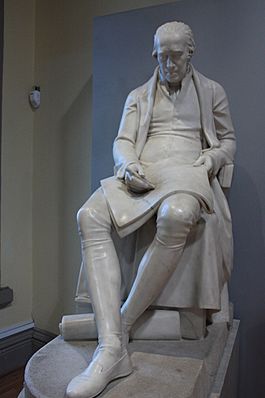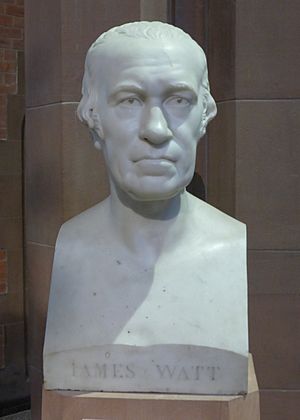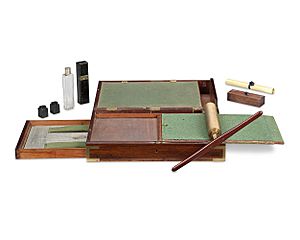James Watt facts for kids
Quick facts for kids
James Watt
FRS FRSE
|
|
|---|---|

Portrait of Watt (1736–1819)
by Carl Frederik von Breda |
|
| Born | 19 January 1736 Greenock, Renfrewshire, Scotland
|
| Died | 25 August 1819 (aged 83) Handsworth, Birmingham, England
|
| Resting place | St. Mary's Church, Handsworth |
| Known for | Watt steam engine Watt's linkage Watt's curve Separate condenser Pneumatic chemistry Butterfly valve Poppet valve Centrifugal governor Horsepower Lap Engine Indicator diagram Letter copying press Rangefinder Resolution (beam engine) Screw-propeller steamer Steam hammer Sun and planet gear |
| Spouse(s) | Margaret Miller (m. 1764–1773 her death) Anne McGrigor (m. 1776) |
| Children | 4 |
| Scientific career | |
| Fields | mechanical engineering |
| Institutions | University of Glasgow Boulton and Watt |
| Influences | Thomas Newcomen Joseph Black Adam Smith John Robison (physicist) John Roebuck James Keir |
| Signature | |
 |
|
James Watt FRS FRSE (/wɒt/; 30 January 1736 (19 January 1736 OS) – 25 August 1819) was a Scottish inventor. He is most known for his Watt steam engine, which contributed to the Industrial Revolution in both his native country, Great Britain, and the rest of the world. The watt, the international unit of power, is named after him.
Contents
Early life and education
James Watt was born on 19 January 1736 in Greenock, Renfrewshire. He was the eldest of the five surviving children of Agnes Muirhead (1703–1755) and James Watt (1698–1782). His mother came from a distinguished family, was well educated and said to be of forceful character, while his father was a shipwright, ship owner and contractor, and served as the Greenock's chief baillie in 1751.
Watt was educated at home by his mother, later going on to attend Greenock Grammar School. There he exhibited an aptitude for mathematics.
After leaving school, Watt worked in the workshops of his father's businesses. After his father suffered unsuccessful business ventures, Watt left Greenock to seek employment in Glasgow as a mathematical instrument maker.
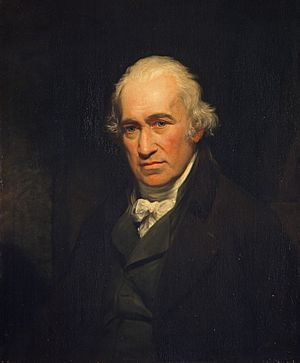
When he was 18, Watt's mother died and his father's health began to fail. Watt travelled to London and was able to obtain a period of training as an instrument maker for a year (1755–56), then returned to Scotland, settling in the major commercial city of Glasgow, intent on setting up his own instrument-making business. He was still very young and, having not had a full apprenticeship, did not have the connections to establish himself as a journeyman instrument maker.
By a stroke of luck, Watt was asked to restore a set of astronomical instruments bequeathed by Alexander MacFarlane to the University of Glasgow. Subsequently, three professors offered Watt the opportunity to set up a small workshop within the university. It was initiated in 1757 and two of the professors, the physicist and chemist Joseph Black as well as the famed economist Adam Smith, became Watt's friends.
At first, he worked on maintaining and repairing scientific instruments used in the university. He made and repaired brass reflecting quadrants, parallel rulers, scales, parts for telescopes, and barometers, among other things.
In 1759, he formed a partnership with John Craig, an architect and businessman, to manufacture and sell a line of products including musical instruments and toys. This partnership lasted for the next six years, and employed up to 16 workers. Craig died in 1765. One employee, Alex Gardner, eventually took over the business, which lasted into the 20th century.
Watt and the kettle
There is a popular story that Watt was inspired to invent the steam engine by seeing a kettle boiling, the steam forcing the lid to rise and thus showing Watt the power of steam. This story is told in many forms; in some Watt is a young lad, in others he is older, sometimes it's his mother's kettle, sometimes his aunt's. Watt did not actually invent the steam engine, as the story implies, but dramatically improved the efficiency of the existing Newcomen engine by adding a separate condenser.
Although it is often dismissed as a myth, the story of Watt and the kettle has a basis in fact. In trying to understand the thermodynamics of heat and steam, James Watt carried out many laboratory experiments and his diaries record that in conducting these, he used a kettle as a boiler to generate steam.
Watt steam engine
While working as an instrument maker at the University of Glasgow, Watt became interested in the technology of steam engines. He realised that contemporary engine designs wasted a great deal of energy by repeatedly cooling and reheating the cylinder. Watt introduced a design enhancement, the separate condenser, which avoided this waste of energy and radically improved the power, efficiency, and cost-effectiveness of steam engines. Eventually, he adapted his engine to produce rotary motion, greatly broadening its use beyond pumping water.
Watt attempted to commercialise his invention, but experienced great financial difficulties until he entered a partnership with Matthew Boulton in 1775.
By 1795, Watt and Boulton purchased a property about a mile away from the Soho Manufactory, on the banks of the Birmingham Canal, to establish a new foundry for the manufacture of the engines. The Soho Foundry formally opened in 1796 at a time when Watt's sons, Gregory and James Jr. were heavily involved in the management of the enterprise. The firm of Boulton and Watt was highly successful and Watt became a wealthy man.
In 1800, the year of Watt's retirement, the firm made a total of 41 engines.
Copying machine
Before 1780, there was no good method for making copies of letters or drawings. Watt decided to try to physically transfer ink from the front of the original to the back of another sheet, moistened with a solvent, and pressed to the original. The second sheet had to be thin, so that the ink could be seen through it when the copy was held up to the light, thus reproducing the original exactly.
Watt started to develop the process in 1779, which required much experimentation, but a year later he had enough success to patent the process. He further developed and perfected his invention before it could be routinely used by others, which took several more years. Watt formed another partnership with Matthew Boulton (who provided financing) and James Keir (to manage the business) in a firm called James Watt and Co. Boulton and Watt gave up their shares to their sons in 1794. It became a commercial success and was widely used in offices even into the 20th century.
Later years
Watt continued to invent other things before and during his semi-retirement. Within his home in Handsworth, Staffordshire, Watt made use of a garret room as a workshop, and it was here that he worked on many of his inventions. Among other things, he invented and constructed machines for copying sculptures and medallions which worked very well, but which he never patented. One of the first sculptures he produced with the machine was a small head of his old professor friend Adam Smith.
He and his second wife travelled to France and Germany, and he purchased an estate in mid-Wales at Doldowlod House, one mile south of Llanwrthwl, which he much improved.
He died on 25 August 1819 at his home "Heathfield Hall" near Handsworth in Staffordshire (now part of Birmingham) at the age of 83. He was buried on 2 September in the graveyard of St Mary's Church, Handsworth. The church has since been extended and his grave is now inside the church.
Family
In 1764, Watt married his cousin Margaret (Peggy) Miller, with whom he had 5 children, 2 of whom lived to adulthood: James Jr. (1769–1848) and Margaret (1767–1796). His wife died in childbirth in 1773. In 1777, he married again, to Ann MacGregor, daughter of a Glasgow dye-maker, with whom he had 2 children: Gregory (1777–1804), who became a geologist and mineralogist, and Janet (1779–1794). Ann died in 1832.
Honours
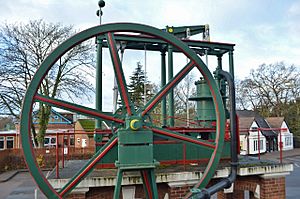
Watt was much honoured in his own time. In 1784, he was made a fellow of the Royal Society of Edinburgh, and was elected as a member of the Batavian Society for Experimental Philosophy, of Rotterdam, the Netherlands, in 1787. In 1789, he was elected to the elite group, the Smeatonian Society of Civil Engineers. In 1806, he was conferred the honorary Doctor of Laws by the University of Glasgow. The French Academy elected him a Corresponding Member and he was made a Foreign Associate in 1814.
Memorials
The approximate location of James Watt's birth in Greenock is commemorated by a statue. Other memorials in Greenock include street names and the Watt Memorial Library, which was begun in 1816 with Watt's donation of scientific books, and developed as part of the Watt Institution by his son (which ultimately became the James Watt College). Taken over by the local authority in 1974, the library now also houses the local history collection and archives of Inverclyde, and is dominated by a large seated statue in the vestibule. Watt is additionally commemorated by statuary in George Square, Glasgow and Princes Street, Edinburgh, as well as others in Birmingham, where he is also remembered by the Moonstones and a school is named in his honour.
The James Watt College has expanded from its original location to include campuses in Kilwinning (North Ayrshire), Finnart Street and The Waterfront in Greenock, and the Sports campus in Largs. Heriot-Watt University near Edinburgh was at one time the School of Arts of Edinburgh, founded in 1821 as the world's first Mechanics Institute, but to commemorate George Heriot, the 16th-century financier to King James VI and I, and James Watt, after Royal Charter the name was changed to Heriot-Watt University. Dozens of university and college buildings (chiefly of science and technology) are named after him. Matthew Boulton's home, Soho House, is now a museum, commemorating the work of both men. The University of Glasgow's Faculty of Engineering has its headquarters in the James Watt Building, which also houses the department of Mechanical Engineering and the department of Aerospace Engineering. The huge painting James Watt contemplating the steam engine by James Eckford Lauder is now owned by the National Gallery of Scotland.
There is a statue of James Watt in Piccadilly Gardens, Manchester and City Square, Leeds.
A colossal statue of Watt by Francis Legatt Chantrey was placed in Westminster Abbey, and later was moved to St. Paul's Cathedral. On the cenotaph, the inscription reads, in part, "JAMES WATT ... ENLARGED THE RESOURCES OF HIS COUNTRY, INCREASED THE POWER OF MAN, AND ROSE TO AN EMINENT PLACE AMONG THE MOST ILLUSTRIOUS FOLLOWERS OF SCIENCE AND THE REAL BENEFACTORS OF THE WORLD".
A bust of Watt is in the Hall of Heroes of the National Wallace Monument in Stirling, Scotland.
Interesting facts about James Watt
- Watt is said to have suffered prolonged bouts of ill-health as a child and suffered from frequent headaches all his life.
- Watt was featured on a £50 note issued by the Bank of England on November 2, 2011 along with Boulton. The inclusion of Watt is the second time that a Scot has featured on a Bank of England note (the first was Adam Smith on the 2007 issue £20 note).
- The garret room workshop that Watt used in his retirement was recreated in its entirety and put on public display as part of a new permanent Science Museum exhibition, "James Watt and our world" in March 2011.
- In 2011, Watt was one of seven inaugural inductees to the Scottish Engineering Hall of Fame.
Patents
Watt was the sole inventor listed on his 6 patents:
- Patent 913: A method of lessening the consumption of steam in steam engines – the separate condenser. The specification was accepted on 5 January 1769; enrolled on 29 April 1769, and extended to June 1800 by an Act of Parliament in 1775.
- Patent 1,244: A new method of copying letters. The specification was accepted on 14 February 1780 and enrolled on 31 May 1780.
- Patent 1,306: New methods to produce a continued rotation motion – sun and planet. The specification was accepted on 25 October 1781 and enrolled on 23 February 1782.
- Patent 1,321: New improvements upon steam engines – expansive and double acting. The specification was accepted on 14 March 1782 and enrolled on 4 July 1782.
- Patent 1,432: New improvements upon steam engines – three bar motion and steam carriage. The specification was accepted on 28 April 1782 and enrolled on 25 August 1782.
- Patent 1,485: Newly improved methods of constructing furnaces. The specification was accepted on 14 June 1785 and enrolled on 9 July 1785.
Images for kids
-
Original condenser by Watt (Science Museum)
-
The ruin of Watt's cottage workshop at Kinneil House
-
Cylinder fragment of Watt's first operational engine at the Carron Works, Falkirk
-
Engraving of a 1784 steam engine designed by Boulton and Watt
-
A steam engine built to James Watt's patent in 1848 at Freiberg in Germany
-
James Watt's letters from the Science Museum Library & Archives in Wroughton, near Swindon
-
Scientific apparatus designed by Boulton and Watt in preparation of the Pneumatic Institution in Bristol
-
An 1835 painting of "Heathfield", Watt's house in Handsworth, by Allen Edward Everitt
-
Chantrey's statue of James Watt
See also
 In Spanish: James Watt para niños
In Spanish: James Watt para niños


